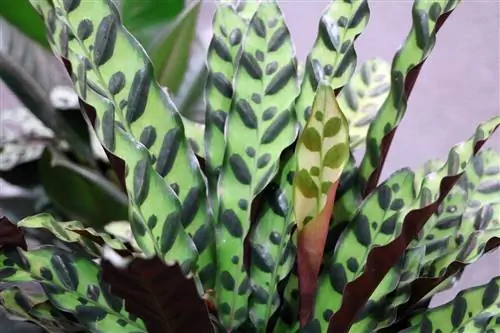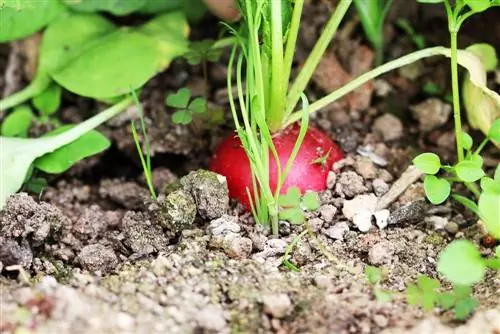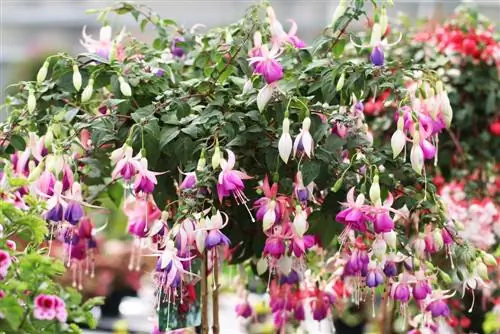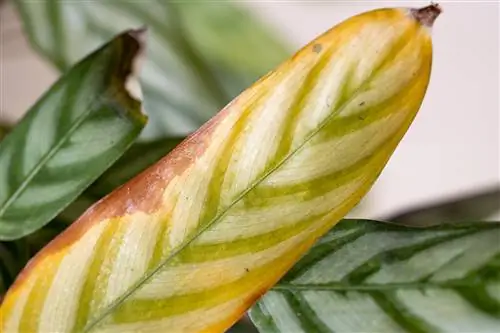- Author admin [email protected].
- Public 2023-12-17 03:39.
- Last modified 2025-01-24 12:45.
Are you struggling with a corner of your living space that is basically too shady for plants? Then the basket marante is an excellent solution. The tropical ornamental leaf plant scores with a nonchalant attitude towards poor lighting conditions, as long as it is warm enough at the location.
Among the multifaceted varieties, the plain-colored Calathea rufibarba and the distinctively marked Calathea makoyana are particularly undemanding in all other aspects of care. You can read about what is important in your cultivation here.
Location
The calm attitude towards the lighting conditions at the location makes the basket marante an extremely versatile houseplant. As the following expectations regarding light and temperature conditions show, the function of the arrowroot plant is by no means limited to problem solving:
- partially shady to shady location
- shade in a sunny spot with curtains or a featured plant
- warm with temperatures not below 18 °C
- no risk of cold drafts
High humidity of more than 70 percent plays a central role in the professional care of Calathea rufibarba and makoyana. If they are not cultivated in a greenhouse, appropriate precautions should be taken in their immediate surroundings. A humidifier creates a tropical climate, as does a babbling indoor fountain. Alternatively, fill the coaster with pebbles and water. As part of evaporation, the plant is permanently surrounded by humidified air.
Tip:
If the temperature level permanently exceeds the 25 degree mark, the basket marante is sprayed daily with low-lime water.
Substrate
Since the green plants rely on a certain level of nutrients, the preferred substrate is high-quality compost-based potted plant soil. You can optionally mix it yourself by combining 3 parts compost or leaf mold with 1 part peat or peat substitute. To create good permeability, add a handful of perlite or expanded clay. A slightly acidic pH value of 4.5 to 5.5 has a beneficial effect on the growth of the tropical beauty.
Pouring
Based on its genetic makeup, the basket marante knows two seasons: the warm, humid rainy season and the cool, dry season. The better these tropical climate conditions are simulated, the more at home Calathea rufibarba and makoyana will feel in your living room. Therefore, design the water supply in this rhythm:
- Keep the substrate constantly moist from April to October.
- As soon as the soil dries, water with low-lime water.
- If the coaster is not filled with pebbles, it will be emptied after 20 minutes.
- Slightly reduce the amount of watering from November to March.
- The root ball must not dry out at any time.
The ornamental plant interprets the reduction in the water supply as the beginning of the cool dry season, so that it immediately adapts to winter conditions with lower temperatures. The minimum of 18 °C must not be undercut in order not to incur the displeasure of the exotic roommates.
Fertilize
In order to produce the magnificent leaves, an uninterrupted supply of nutrients is required. This care aspect also takes into account the different requirements between the summer growth phase and the winter dry dormancy.
- apply liquid fertilizer every 14 days from April to October
- from November to March extend the rhythm to every 4-6 weeks
- Do not fertilize in the year after purchase or repotting
The fertilizer preparation must not be applied to dried substrate. If in doubt, pour a little with clear water first.
Cutting
The basket marante accepts pruning at any time. Simply cut out withered leaves with scissors. The same applies to withered flowers. Pruning in early spring, shortly before new growth, causes the least stress.
Bring to bloom
In order to encourage the tropical plant to bloom, a targeted impulse is required. Do not rely on the first flower after purchase, as this results from a short-day imitation by the hand of the professional gardener. To attract the pretty inflorescence regularly in the following years, follow these steps:
- from mid-August place the Calathea under a dark hood from 6 p.m. to 8 a.m.
- repeat this process daily for 4-6 weeks
In combination with reducing irrigation water, you will convince the basket marante of the beginning of the dry season, which is accompanied by beautiful flowering.
Repotting
If the root ball no longer finds enough space in the pot, the care protocol is expanded in spring to include repotting. The new planter is a maximum of 5 cm larger in circumference and has a bottom opening for water drainage.
- Drainage made of grit or clay shards over the hole in the ground effectively prevents waterlogging
- fill in a layer of substrate on top and press lightly
- potting the basket marante to shake off the used soil
- insert in the middle, fill the cavities and pour in
- A pouring rim of 2 to 3 cm makes sense
Experienced hobby gardeners take this opportunity to take a close look at the root ball. Rotten, obviously troublesome roots are cut out and tangles are pulled apart with both hands.

Propagate
You can handle the offspring of Calathea rufibarba and makoyana in two different ways. It's completely uncomplicated by dividing it. The cutting method requires a little more effort.
Division
This form of propagation also serves as effective rejuvenation. Pot the plant out during the main vegetation period. Use a sharp, disinfected knife to cut the root ball into several pieces. Each segment should have 2-3 shoots. Without much delay, plant the pieces in individual pots to care for them like an adult specimen right from the start.
Cuttings
If you can't bring yourself to attack your ornamental leaf plant with a knife, you can use top cuttings. He althy, vital leaves with at least two leaves are suitable. They are cut just below a bud to a length of 10-15 centimeters.
- Fill cultivation pots with nutrient-poor substrate
- Insert half of each cutting and water it
- spend in a mini greenhouse in a partially shaded place
At temperatures of 22-24 °C, rooting takes about 4 weeks. During this time, keep your pupils constantly moist and ventilate regularly. After root formation, the temperature can be reduced to 18-20 °C.
Leaf Care
If you follow the instructions in these care instructions, the basket marante will present itself in a lush dress of leaves. Due to their size, they not only act as eye catchers but also as dust catchers. You can effectively counteract this shortcoming with the following simple measures:
- Wipe dusty leaves with a damp cloth
- Additional shine is given by a little algae juice on the underside and top of the leaves
- alternatively rub the leaves with the inside of a banana peel
A shower is less recommended. The tropical plant is so sensitive that it has difficulty surviving the shock.
Conclusion of the editors
The elegant basket marant is quickly appreciated by the hobby gardener and is given a few care-giving attentions. If it is never cooler than 18 °C at the location, it can also be in the shade. If the humidity hovers around 70 percent, the prospects for successful cultivation of Calathea rufibarba and makoyana are good. The decorative foliage plant feels particularly at home when the water and nutrient supply simulates the tropical rainy and dry seasons.
What you should know about Calathea rufibarba and makoyana in brief
General care instructions
- Although these two species are somewhat different in their care, origin and requirements, they also have clear similarities.
- The C. rufibarba comes from the tropical rainforests of South Africa, the C. makoyana is native to Brazil.
- The leaves of Calathea rufibarba are narrow and long, while Calathea makoyana has more rounded leaves.
- Both species require relatively high humidity for their growth, which must be constant at values between 60-80%.
- A room temperature of 20-25 °C is a must, especially in summer. In winter the temperatures can drop to a maximum of 18 °C.
- A bright to partially shaded place is recommended; direct sunlight should be avoided.
- Both species like it slightly moist. Therefore, you should make sure that the root balls do not dry out. Water moderately!
- It is recommended to use rainwater for watering. Tap water should be boiled, or at least left to stand overnight.
- Young plants are repotted annually in spring, older plants every 2-3 years, depending on their growth rate.
- So-called pot bowls are ideal as planters, because the roots of the two Calathea species grow more in width than in depth.
- Reproduction is the same for both species. By dividing the canes when repotting.
Substrate & flower formation
- While the Calathea rufibarba gets by with permeable standard soil, the Calathea makoyana needs slightly acidic soil.
- This can be achieved by mixing peat with a little coniferous or leaf mold.
- The Calathea rufibarba produces pretty, yellow flowers that grow directly from the ground.
- In order to achieve flower formation, the plants receive a maximum of 10 hours of light per day in autumn.
- Too much light can be avoided by using a cardboard box to cover the plant.
- A lack of the same should be compensated for with special growth lamps.
Location & Fertilization
- The nutrient requirements for both plants are within the normal range.
- In their growth phase, the plants receive 0.1% fertilizer every 14 days.
- Dry air and soil are just as difficult to tolerate as waterlogging.
- With optimal care, pest infestation is not to be expected. However, air that is too dry causes spider mite infestation.
- The Calathea makoyana is a typical warm house plant. You won't have much luck with her in the living room.
- Calathea rufibarba also thrives in a converted flower window - preferably not directly on the cold windowsill.
- A polystyrene sheet alleviates the cold emanating from marble window sills.
- A location on a wooden platform, near a window, is even better.






